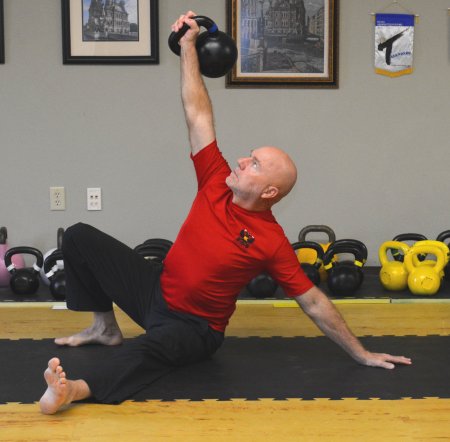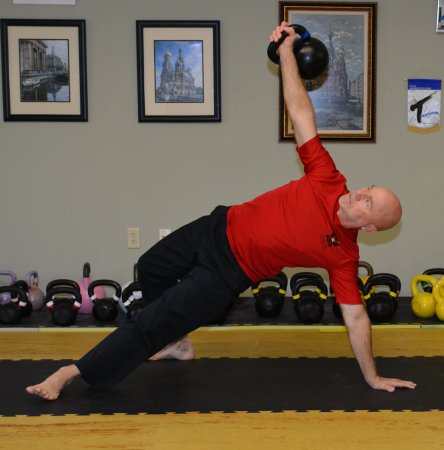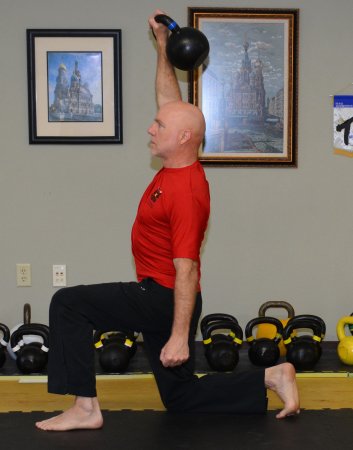The "Core" Issue
by Jay Armstrong - April 2014
Why Exercise?
Why are you exercising? One of the reasons I often hear is “I want to strengthen my core”. To do this many people are doing exercises (or thrashing about) while standing on an unstable surface such as a wobble board or a Bosu ball.
Another popular technique for developing a strong core is the plank. Now, I am a big fan of the plank since it demonstrates the principles of connection, linkage, tension, lengthening, etc. However, spending lots and lots of time practicing the plank will make you really good at doing the plank. This is particularly valuable if you fear that you might fall down in a dirty place with spiders and snakes on the floor and you will need to hold that position (about 8 inches above the ground) and be very still for an extended period of time.
A strong core that is only strong while you are stationary is pretty much useless. You need a core that can be strong while you are in motion. This requires two things:
- a core that is resistant to loading in a variety of directions, and
- the ability to use your arms and legs while your core is stabilized.
Enter the Turkish Getup.
Stability in Motion
This is a perfect example of a skill that requires a stabile core while the body is in motion. The weight overhead is supported and lifted by force directed into the ground. This force must go through limbs that are connected to a solid and strong core.
 |
|
The ability to maintain spinal length during movement is an essential element for most athletic activities. The muscles on our back put the spine into extension while the muscles on the front of the body put us into flexion. Both sets of muscles plus the muscles on the sides of our trunk must have a balanced amount of contraction in order to stabilize the spine in this straight, elongated position. You may consider this to be a good postural position and a corrective exercise for the many hours you spend hunched over your iPhone texting your friends.
|
The Seated Position
The first move of the Turkish Getup involves moving from a supine (or lying) position to a seated position. If you tuck your chin and curl your spine into flexion as you perform this movement you will find that it pulls your arm forward, causes your leg to rise, and makes it very difficult to move into the seated position. Contract your abs while simultaneously opening your chest and lengthening from your head to your tailbone. This requires “core strength” in motion as you move from the lying position to the seated and nearly vertical spine position. The downward force of the kettlebell must travel through the arm, through the “core” and into the floor.
Kneeling Position
Transitioning from the seated position to the kneeling position is the second move of the Turkish Getup. During this phase you will pick up your hips and put one knee under yourself. Simultaneously pushing into the floor with one hand and one foot puts significant force into the side of your torso. So, your core will develop strength and stability from the side of your body. This is one of the areas often missed during popular core training sessions and it can be difficult to load in a practical manner. Increasing the weight or slowing down the transitional movement will both add load to this lateral core training drill. |
|

|
Standing Position
Finally, you will move from the kneeling position to the standing position (or perform a one-arm, overhead lunge). For most people this is a very challenging movement pattern.
 |
|
Tight hip flexors and a rounded thoracic spine encourage the spine to pitch forward as the knee comes off of the ground. This will be accompanied by increased extension or rounding of the lower back or lumbar spine. Stabilize your low back by tightening your glutes and abs as you begin the ascent. Visualize the top of your head rising or being pulled upward by an invisible string. Of course, you may need to do significant, additional work to improve your thoracic mobility and to open up those restrictive hip flexors. However, the ability to stand up and kneel down with a strong, connected, and stabile core is an essential movement skill and is well worth the effort you put into improving this skill.
|
The Turkish Getup provides a wealth of opportunities for developing that all-elusive “strong core” in a straightforward and practical manner. It may not provide you with all of the excitement of holding a gut-wrenching, 5-minute plank but the type of core strength that you will develop will serve you well in other athletic movement patterns.
Need help finding zone between comfort and panic? Jay Armstrong is a Senior RKC Instructor and a Master Z-Health Trainer located in the Houston area. Jay conducts group kettlebell and mobility classes and sees clients on a one-on-one basis to create pain-free, lifelong exceptional athleticism. Contact Jay today at jay@themovementpro.com.
(Many thanks to Dr. Bob Rakoswki for suggestions on this article.)
|